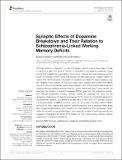| dc.contributor.author | Bolton, Andrew D. | |
| dc.contributor.author | Constantine-Paton, Martha | |
| dc.date.accessioned | 2020-07-30T00:25:27Z | |
| dc.date.available | 2020-07-30T00:25:27Z | |
| dc.date.issued | 2018-06 | |
| dc.date.submitted | 2018-01 | |
| dc.identifier.issn | 1663-3563 | |
| dc.identifier.uri | https://hdl.handle.net/1721.1/126438 | |
| dc.description.abstract | Working memory is the ability to hold information "online" over a time delay in order to perform a task. This kind of memory is encoded in the brain by persistent neural activity that outlasts the presentation of a stimulus. Patients with schizophrenia perform poorly in working memory tasks that require the brief memory of a target location in space. This deficit indicates that persistent neural activity related to spatial locations may be impaired in the disease. At the circuit level, many studies have shown that NMDA receptors and the dopamine system are involved in both schizophrenia pathology and working memory-related persistent activity. In this Hypothesis and Theory article, we examine the possible connection between NMDA receptors, the dopamine system, and schizophrenia-linked working memory deficits. In particular, we focus on the dopamine breakdown product homocysteine (HCY), which is consistently elevated in schizophrenia patients. Our previous studies have shown that HCY strongly reduces the desensitization of NMDA currents. Here, we show that HCY likely affects NMDA receptors in brain regions that support working memory; this is because these areas favor dopamine breakdown over transport to clear dopamine from synapses. Finally, within the context of two NMDA-based computational models of working memory, we suggest a mechanism by which HCY could give rise to the working memory deficits observed in schizophrenia patients. | en_US |
| dc.description.sponsorship | National Eye Institute (Grant 5R01EY-014074-18) | en_US |
| dc.language.iso | en | |
| dc.publisher | Frontiers Media SA | en_US |
| dc.relation.isversionof | http://dx.doi.org/10.3389/fnsyn.2018.00016 | en_US |
| dc.rights | Creative Commons Attribution 4.0 International license | en_US |
| dc.rights.uri | https://creativecommons.org/licenses/by/4.0/ | en_US |
| dc.source | Frontiers | en_US |
| dc.title | Synaptic Effects of Dopamine Breakdown and Their Relation to Schizophrenia-Linked Working Memory Deficits | en_US |
| dc.type | Article | en_US |
| dc.identifier.citation | Bolton, Andrew D. and Martha Constantine-Paton. "Synaptic Effects of Dopamine Breakdown and Their Relation to Schizophrenia-Linked Working Memory Deficits." Frontiers in Synaptic Neuroscience 10 (June 2018): 16 © 2018 The Authors | en_US |
| dc.contributor.department | McGovern Institute for Brain Research at MIT | en_US |
| dc.relation.journal | Frontiers in Synaptic Neuroscience | en_US |
| dc.eprint.version | Final published version | en_US |
| dc.type.uri | http://purl.org/eprint/type/JournalArticle | en_US |
| eprint.status | http://purl.org/eprint/status/PeerReviewed | en_US |
| dc.date.updated | 2019-09-30T16:36:24Z | |
| dspace.date.submission | 2019-09-30T16:36:29Z | |
| mit.journal.volume | 10 | en_US |
| mit.metadata.status | Complete | |
